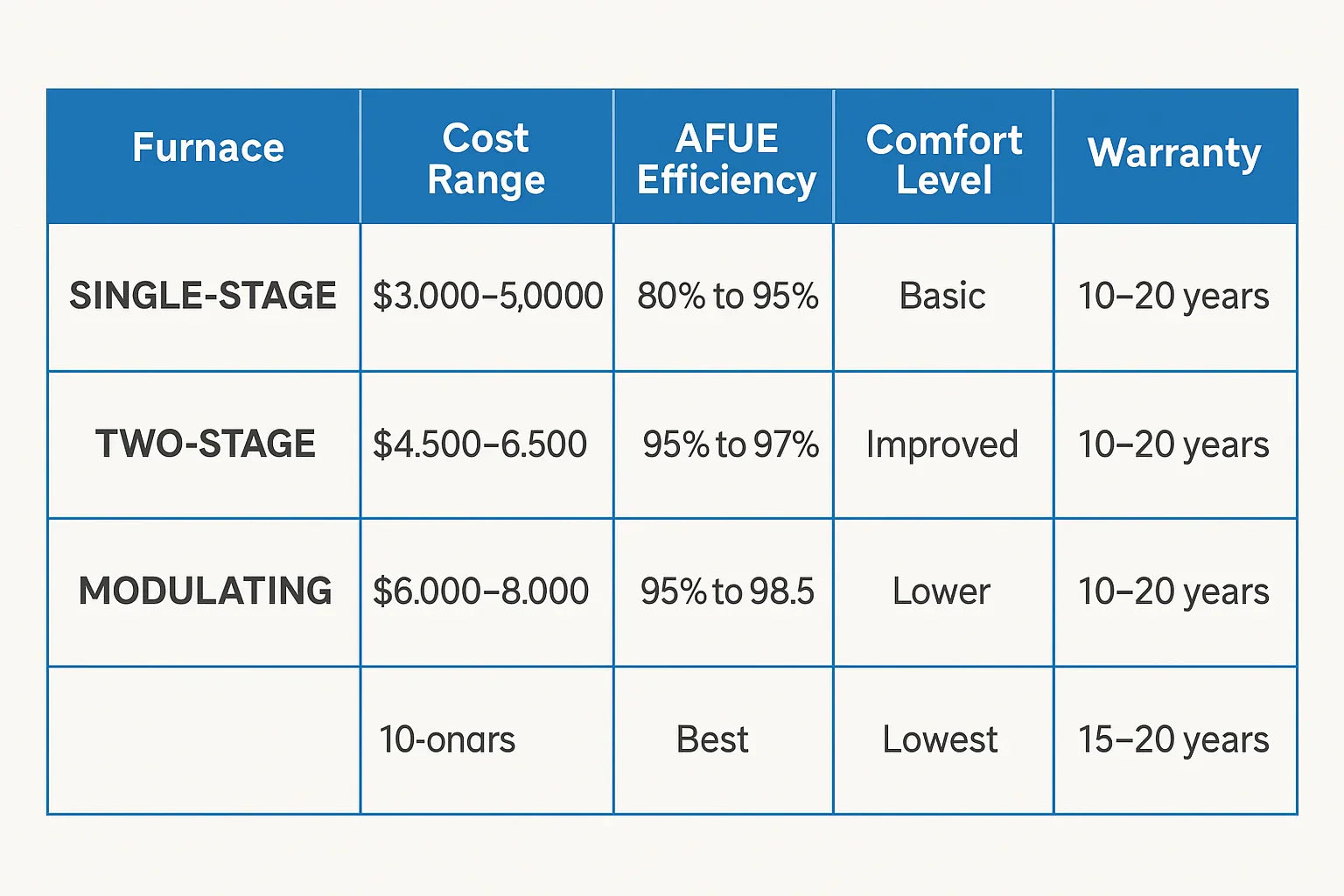If you’ve started shopping for a new furnace, you’ve probably noticed that some models come with features like “two-stage” or “modulating” operation — and they almost always carry a higher price tag than standard single-stage units. The big question: is that extra cost worth it?
In this guide, we’ll break down the price difference in 2025, the factors that affect it, and how to decide whether these higher-performance furnaces make sense for your home.
📘 Not sure about baseline pricing? Start here: How Much Does a New Furnace Cost?
Understanding Single-Stage, Two-Stage, and Modulating Furnaces
Before we talk about cost, let’s clear up what each type actually does:
-
Single-stage furnaces run at full power every time they turn on. They’re simple, reliable, and usually the most affordable.
-
Two-stage furnaces have two heat output levels — high for very cold days, and low for milder weather. This helps reduce temperature swings and can save energy.
-
Modulating furnaces adjust their heat output in small increments, often between 40–100% capacity. This allows for extremely precise temperature control, improved efficiency, and very quiet operation.
The more advanced the control, the smoother the comfort — but also the higher the initial investment.
Average Cost Difference in 2025
When comparing installed prices, here’s what you can generally expect:
-
Two-stage furnace: $4,500–$7,500 installed
-
Modulating furnace: $6,000–$9,500 installed
-
Price difference vs. single-stage: About $500–$3,000 more
According to HomeAdvisor, location, brand, and size can all shift these numbers. Premium brands or high AFUE ratings can easily push prices to the top end of the range.
Factors That Affect Upgrade Pricing
Several variables influence how much more you’ll pay for a two-stage or modulating furnace:
-
Brand and model tier – Higher-end models often include upgraded blower motors and smart features.
-
AFUE rating – High-efficiency (95%+) models typically cost more.
-
System size – Bigger homes require larger units, which cost more to purchase and install.
-
Installation complexity – Ductwork modifications, venting updates, or electrical upgrades can add to the bill.
-
Bundled installations – Replacing your furnace and AC at the same time can increase cost but reduce labor expenses per unit.
When Paying Extra Makes Sense
Two-stage and modulating furnaces offer benefits that go beyond energy savings:
-
Comfort in cold climates – The ability to run at lower output means fewer hot/cold swings and better distribution.
-
Improved multi-story heating – Lower-stage operation helps maintain even temperatures across floors.
-
Noise reduction – Lower-speed operation is much quieter, especially at night.
-
Better humidity control – Modulating systems often do a better job balancing indoor humidity in winter.
According to Carrier’s guide on how gas furnaces work, advanced two-stage and modulating systems can improve seasonal efficiency, especially in areas with long heating seasons.
When to Skip the Upgrade
While the benefits are real, not every home will see a fast payback:
-
Mild climates – If your furnace runs only a few months a year, the efficiency gains may be minimal.
-
Short-term ownership – If you plan to move within 3–5 years, you may not recoup the added cost through energy savings.
-
Budget constraints – If upgrading forces you into high-interest financing, the long-term math may not work in your favor.
ENERGY STAR’s hiring tips recommend evaluating the total cost of ownership, not just the purchase price, when comparing furnace models.
How to Get the Best Price
Whether you’re leaning toward a two-stage or modulating furnace, here’s how to avoid overpaying:
-
Get multiple bids – Compare at least three quotes from licensed contractors.
-
Look for rebates and incentives – Use the DSIRE database to find state and utility programs.
-
Ask about off-season deals – Installation during spring or early fall can mean lower labor rates.
-
Bundle replacements – If your AC is due soon, replacing both at once can save on labor.
For more on how heating systems work and what affects efficiency, see the U.S. Department of Energy’s home heating systems guide.
Final Thoughts
Two-stage and modulating furnaces aren’t just premium options — they’re designed to deliver steadier heat, quieter operation, and better energy efficiency. While you’ll pay $500 to $3,000 more than a single-stage model, the upgrade can be worth it if you live in a cold climate, have multiple floors, or want fewer temperature swings.
If you’re in a milder region or planning to move soon, the return on investment may be limited. In that case, a high-efficiency single-stage furnace could give you the comfort you need at a lower cost. Either way, comparing multiple quotes and checking for rebates will help you get the best value.
📘 Next up: Can You Buy a Furnace Online? Cost Pros and Cons Explained — see how buying direct stacks up against traditional dealer installs.
Alex Lane
Your Home Comfort Advocate







